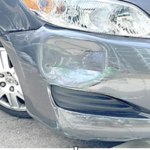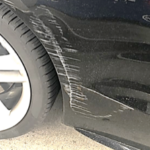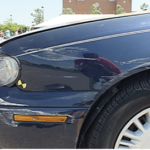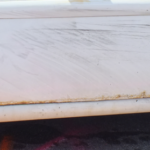As interest rates and financial pressures on families continue to mount, more and more drivers may be unable to pay their repair bill for damage they caused or for mechanical issues on their vehicles. A common response is auto insurance fraud. After all, it’s only the big insurance company that will take a hit, right?
Auto insurance fraud is an industry-wide problem, with estimates suggesting that up to 15% of all auto premiums paid are used directly to cover undetected fraudulent claims, resulting in a direct impact on the premiums paid by consumers. One of the most common forms of insurance fraud is exactly the scenario mentioned above—either the driver reports a crash that never happened, or the driver is intentionally involved in an accident to cover up pre-existing issues and have them repaired too. It is in the insurer’s and public’s best interest to investigate any claims that don’t add up or seem suspicious. The investigating expert needs to have a keen eye for the details that could make or break your claim.
Physical Damage: Decoding the Clues

As with all collision reconstruction cases, proper analysis relies heavily on the physical evidence including the damage to the vehicles. Initially, experts will try to confirm key details of the insured’s statement. For example, if the insured states they were parallel parked on the side of the road and were sideswiped, does the damage correspond to the correct locations on the driver’s side and rear of the vehicle? Is the damage exhibited by a single area on the vehicle, or are there multiple distinct/discontinuous areas of damage?
Once the “big picture” items of the insured’s statement are confirmed, it is possible to delve deeper into the specifics. Here, investigators begin to look at the damage patterns, noting the height, direction, depth, and other details of any dents, scuffs/scratches, deformation, or transfers. These are key details that can help determine whether the damage potentially resulted from contact with another vehicle. The nature and characteristics of the damage are also important to consider. How abrasive are the scratches? How abruptly do they begin and end? Do they begin low on the vehicle and extend continuously higher up on the vehicle? Are there any paint or material transfers? If so, is it excessive? Note that automotive paint on vehicle components typically has an external coating (i.e., clear coat), which prevents the paint from transferring onto other vehicles in excessive amounts. Poles, barriers, walls, and other stationary objects, however, normally do not have such a paint coating, which often results in excessive amounts of the paint being transferred to vehicles that strike them. Excessive paint transfer observed on vehicles is often a strong sign that the vehicle contacted a painted stationary object.
Paint Transfers: What They Reveal
If paint transfers are present, samples of the transfer as well as the adjacent, undamaged paint of the subject vehicle can also be sampled. These paint samples are analyzed in a laboratory,

which can provide the chemical composition of the samples. The chemical composition of the transferred paint is then compared with the known chemical composition of paints commonly used in the automotive industry over the past 20-30 years. With this analysis, it is possible to confirm whether the paint transferred to the subject vehicle was automotive in nature, or, for example, more consistent with paints or coatings used in architectural applications, such as on a concrete barrier or parking garage pole/pillar.
Some of the other observations experts look for include the presence/absence of tire marks deposited on the vehicle, as well as rotational scratches on the vehicle’s wheels and side panels. In addition, investigators will look at the shape/profile of the damage and determine whether there are any dents that are too narrow/localized to have resulted from any component on another typical vehicle. All these observations could aid forensic experts in assessing whether the incident occurred as reported.
The Role of Event Data Recorders (EDRs)
An event data recorder (EDR or “black box”) download is an integral part of most investigations. This is where the insured’s statement of events is critical—did they leave their vehicle running when the damage occurred? Given the EDR will only record data when the vehicle is powered on, if the reported information indicates that the vehicle was off (as they typically do in hit and run claims), no related events should be stored on the EDR. If an event is present, and the recorded data are consistent with the physical damage, this may cast significant doubt on the provided story.

If no event is recovered by the EDR download, things can get a bit more complicated. Of course, there could be no events recovered because the vehicle was reportedly off at the time. But there could also be no event because the impact was not severe enough to reach the recording threshold for a non-deployment event (an event that is severe enough to be recorded, yet not severe enough to warrant any deployments) to be recorded; the possibilities go on. Overall, if the damage is consistent with a relatively severe collision, and no event is recovered, this would indicate that the vehicle was most likely off at the time of the collision, and the reported sequence of events is likely untruthful.
Infotainment and Telematics: Following the Digital Thread
In addition to EDR downloads, modern vehicles can often record an incredible amount of data in their infotainment and telematics units. Often, this data includes GPS tracklogs—analogous to Hansel’s “breadcrumb trail”—of the vehicle’s whereabouts over the preceding days and, for certain vehicles, even weeks and months. This allows forensics experts to analyze aspects of the reported story such as the date, time, and location of the reported loss. Consider an instance where tracklogs illustrate a vehicle having left a repair facility several hours before the vehicle was allegedly struck while parked. This can indicate that there was pre-existing damage to the vehicle, and that the insured was unwilling or unable to pay their repair bill. Aside from tracklogs, any vehicle event (device, door opening, power, ignition, etc.) recorded at/during the period when the vehicle was reportedly parked and unattended can also indicate the incident did not occur as reported.
The Power of Dash-Cams to Capture the Unseen

Finally, the most convincing source of digital data is often the dash cam. Most people will have seen videos of car crashes on YouTube, but many dash-cams can also be configured to record video when the vehicle is off or parked and unattended. If an insured provides such video, it may even have captured the license plate of the offending party. Even if the insured does not provide dash cam footage, modern vehicles, particularly many newer Toyota and General Motors models, have built-in frontal cameras that can be accessed through certain digital tools and software. These cameras trigger a snapshot image based on the activation of various safety systems and may provide irrefutable proof that the insured vehicle was in motion when it contacted another vehicle.
Mechanical Condition: A Deeper Look at Vehicle Health
A thorough examination can reveal additional damage to the vehicle that was not reported as being part of the claim. This can include unrelated collision damage, chronic issues such as rust, major mechanical/electrical issues, or deferred maintenance. During vehicle examination experts often check and test the different mechanical and electrical components of the vehicle. They also often download the vehicle’s diagnostic trouble codes (DTCs) which can assist in assessing the overall condition of the vehicle. In many cases, this extra documentation of the vehicle can make or break the file for a client. While unrelated issues with the vehicle do not immediately indicate fraudulent behavior, it does potentially provide a motive for the same. Additionally, the line of questioning that unrelated damage provides for our clients to discuss with their insured can potentially result in a slip-up in the insured’s story.
This article has touched on only a handful of the ways that forensic experts handle a potentially fraudulent auto insurance claim. Of course, every circumstance and every claim are different. Get in touch with the right experts to discuss how they can assist in uncovering the truth about the nature of the damage to your insured’s vehicle and help prevent insurance fraud from growing.
Was this article valuable?
Here are more articles you may enjoy.

 Asahi Sales Drop Worsens as Cyber Hack Disruption Lingers
Asahi Sales Drop Worsens as Cyber Hack Disruption Lingers  Abbott Presses Congress for Shield Over Preemie Baby Formula Litigation That Could Cost It Billions
Abbott Presses Congress for Shield Over Preemie Baby Formula Litigation That Could Cost It Billions  Florida And East Coast Will See Big Losses From More Cat 5 Storms, Researchers Say
Florida And East Coast Will See Big Losses From More Cat 5 Storms, Researchers Say  California Again Delays Wildfire Protection Rules for Homes
California Again Delays Wildfire Protection Rules for Homes 